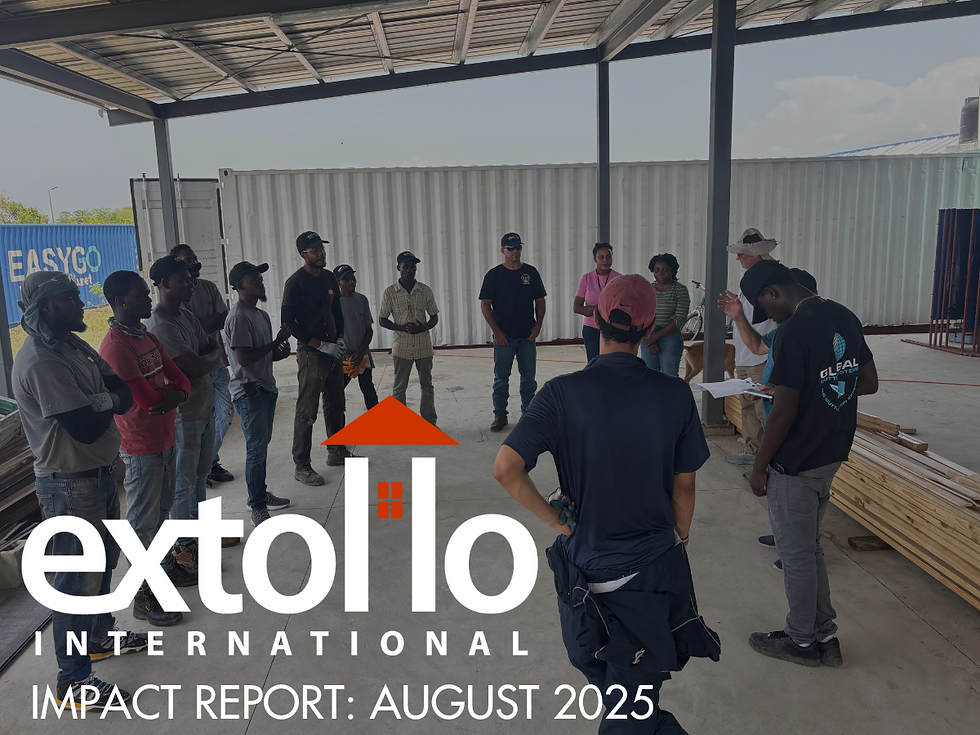Still Sorrowful, But Not Crying
- Bruce Kirkpatrick
- Jan 19, 2019
- 3 min read
Updated: Sep 25, 2020

The last time I visited Haiti, I cried for most of the first day on the island. The living conditions, the air, the trash, the smells, the poverty—it was all too overwhelming.
I just returned from Haiti, and this time, I see hope.
The first thing I noticed when my American Airlines flight landed in the capital, Port au Prince, was that the airport had gone through a major renovation. Now air conditioning filtered throughout, baggage claim buzzed with something close to efficiency, and the crowds consisted of mostly Haitians flying home from visits abroad, not missionaries flying into the country to lend a hand.
Next, I marveled that the roads no longer shook the fillings in my teeth as we travelled to the Extollo Training Center, about 45 minutes away. The major thoroughfares had been repaved and traffic—despite the lack of stoplights or stop signs—moved along. (I saw one working stoplight in Port au Prince; and stop signs are merely suggestions). We rarely saw gridlock, although Haitians creating four or five lanes of traffic on a two-lane road was common. I’m glad somebody else was driving!
In the U.S. garbage isn’t much of an issue. In Haiti, where services are overwhelmed or even non-existent, it is. This trip I noticed that there was way less garbage on the streets. To me this means that Haitians are beginning to tackle this problem. I still saw and smelled many small garbage fires, little plumes of gray smoke trickling into the sky from backyards and homes like tiny smoke signals. It’s one way the Haitians rid themselves or garbage—they burn it. I remember when I was a kid living in the Midwest and I used to rake leaves and burn them on the curb. I always loved the smell of burning leaves—not so much the smell of burning garbage. But it’s progress.
This biggest change in Port au Prince is no more “tent cities.” They’re gone. And it certainly makes for less congestion, better air quality, and smoother traffic. But I also learned that it doesn’t mean people are not homeless anymore. Maybe it just means that the tents were torn down and people moved to other locations—to other misery. Haiti’s still the poorest nation in the Western Hemisphere and that can’t be solved overnight. I didn’t make it to Cite Soleil, one of the biggest slums on the island, and deep down, I really didn’t want to go. I know I’d start to cry again.
Since I returned, many people have asked me if I saw new homes being built. Yes, I did. Many are still unfinished, or half done, with no roofs just walls. Concrete blocks are often stacked in the side yard, waiting to become part of a wall. I didn’t see the earthquake damaged homes I did last time—and new homes are going up—but in the parts of Haiti I visited, there is much more work to be done. Much more.
The biggest change I noticed—people aren’t living on the streets like they used to. After the earthquake of 2010, with so many homes damaged, the only safe place to live was in the open and in cities that means literally on the streets. This trip I didn’t see that. People are settling into homes again—and even if they aren’t complete or poorly built (I saw many built from sticks and boards with metal roofs), shelter is much more available. Yeah!
It’s progress. Maybe slow progress. And progress you and I wouldn’t be comfortable with.
But it’s better.
Better.




Comments